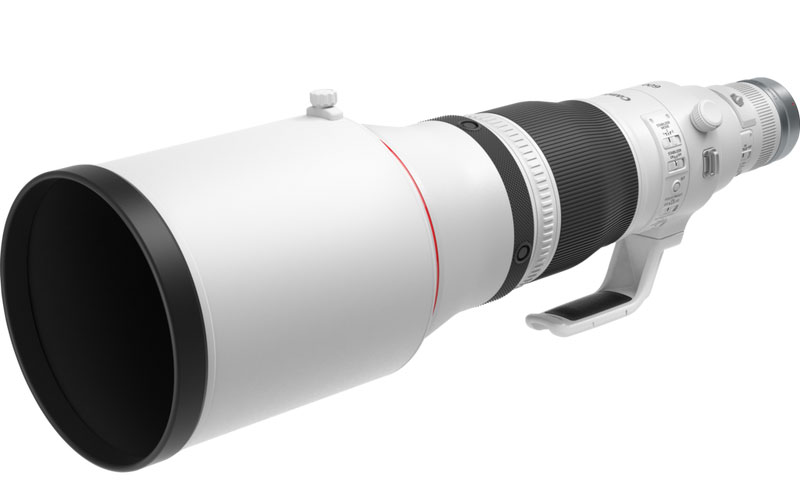Canon RF 600 mm F4 L IS USM lens
The RF 600 mm f4 L IS USM lens is one of a new generation of 'big white' Canon lenses made with the RF mirrorless mount, only compatible with mirrorless bodies such as the EOS R3, R5, R7 and so on. The 600 mm f4 specification is a favourite among bird photographers, offering plenty of focal length and a fast maximum aperture to let in lots of light to freeze the action, while also being of a more or less manageable size. The equivalent lenses with the EF mount (for SLRs and digital SLRs) have been a common sight at twitches and sport events for many years. These older lenses can be used with the new breed of mirrorless cameras with the addition of an EF to RF adaptor, so what benefits does the new RF lens offer?
At a fraction over 3 kg, this lens is the same weight as the mark III version of the EF lens of the same specification, but this is a 25% reduction on the mark II and a colossal 44% lighter than the mark I. A 600 mm f4 is unavoidably a large and unwieldy lens, but I found the 1 kg saving compared to the mark II made a significant difference to handling and general portability.

Performance-wise, it's all top-of-the-range stuff. The autofocus is extremely fast. Image quality is simply stunning. Its sharpness is top drawer, while backgrounds are as you'd expect from a 600 mm f4: smooth and wonderfully out of focus, isolating your subject.
The lens is compatible with RF 1.4x and 2x extenders (more commonly called converters, by bird photographers at least). These are very handy for increasing your reach. I thought autofocus speed, consistency and accuracy were a significant improvement on the EF lens with EF to RF adaptor, particularly with the 2x. The subject snaps into focus very rapidly. The EF to RF adaptor works very well, but the new RF mount contains more electronic contacts (12, compared to eight on the EF, which was introduced in 1987), enabling faster communication between lens and camera, so it's only to be expected that autofocus with an EF lens and adaptor won't be as good as a native RF camera and lens combination. The percentage of sharp images still decreases with the use of converters, particularly the 2x, but the shots it nails are very sharp. The converters look very different to their EF counterparts, suggesting significant advancements in this area.

This Red Grouse was shuffling around in the heather but the lens produced a very narrow depth of field, isolating the subject beautifully (Kit Day).
The RF 600 mm has 5.5 stops of image stabilisation (an improvement of half a stop on the mark III EF lens and 1.5 stops on the mark II), which is particularly useful when shooting handheld. This is not something I'd attempt very often with a 600 mm f4, but it is much more manageable with the reduced weight and improved stabilisation of the RF system. While camera bodies such as the R3 and R5 have IBIS (not Glossy or Northern Bald, but an acronym for 'In-Body Image Stabilisation') which works in tandem with the lens IS for shorter focal length lenses, the benefit is minimal with the RF 600 mm f4 (IBIS sensor shift stabilisation becomes less effective at long focal lengths).

The relatively manageable weight of this lens made it easier to pick up and track birds in flight, such as this Eurasian Curlew (Kit Day).
The RF 600 mm f4 is probably the best lens for bird photography that Canon produces. A more mobile photographer or a 'birder who takes photos' would of course prefer a lighter lens, probably with a zoom, but for sheer quality of images a big prime lens is often the best option if you can put up with the weight and expense. Unfortunately, the cost of the lens is in the same league as several good birding holidays or a car. A second-hand mark II EF mount lens with an adaptor is much cheaper, and while it's 1 kg heavier and the autofocus, image stabilisation and close focus are not quite as good, in many situations it will give indistinguishable image quality. On paper this sounds a compelling option, but the improvements offered by the RF system results in performance that might almost be as superlative as the price. If you're going mirrorless with Canon and get the chance to buy any of the new RF white lenses (including the 100-500 mm f4.5-7.1 recently reviewed in Birdwatch), I'm sure you won't be disappointed. I'm off to pick out my lottery numbers!
Further info
- Price: £14,179
- Size: 168 x 472 mm
- Weight: 3,090 g
- Guarantee: 5 years
Verdict
+ Sharp lens that produces great images
+ Surprisingly lightweight for its size
- Not an easily affordable option

